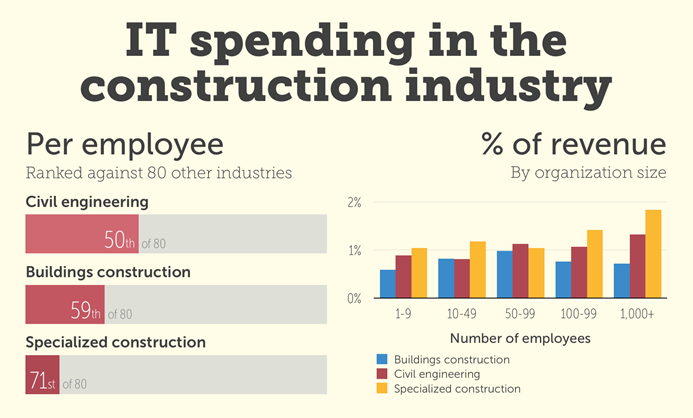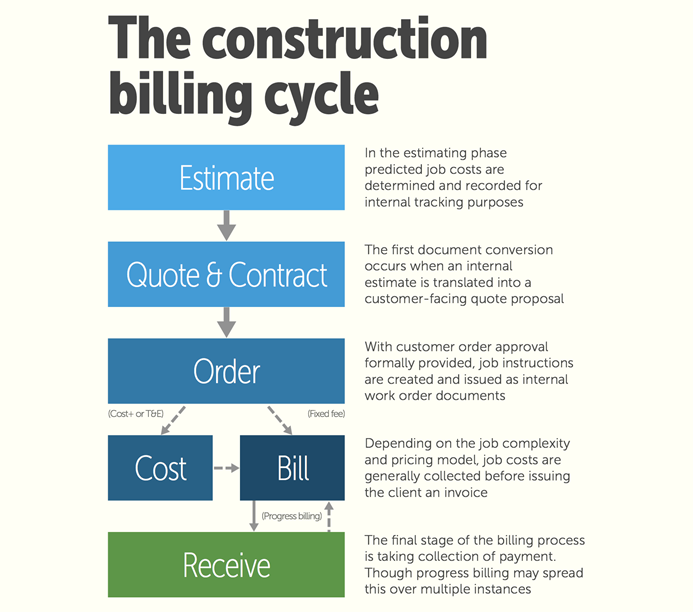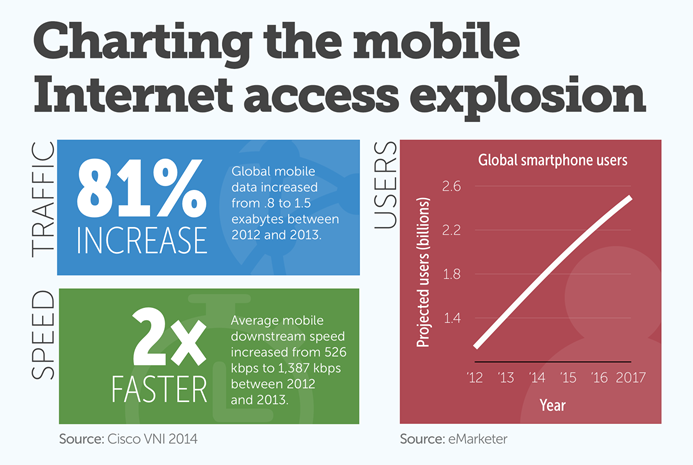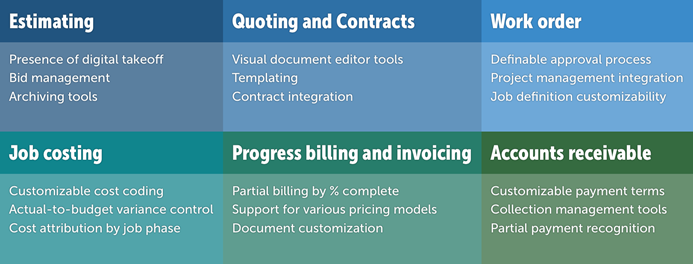Adam Bluemers of FindAccountingSoftware.com recently published an article with insights, statistics, and trends of the Construction Industry spending on IT. This article offers helpful recommendations on bettering the construction billing cycle, a common and overall shared issue in the industry, through software. See how the right accounting software can benefit your efficiency and bottom line in “How to Tame the Construction Billing Cycle Software” guest post below.
Well-managed. Quick. Easy.
Not the terms that come to mind when you think of your construction billing processes?
Then what you’ve got on your hands is a bit of good news, bad news situation.
The bottomline is that construction billing is complicated and unwieldy. But at least it’s an equal opportunity pain-in-the-neck. Your competitors have to deal with it too!
If you are struggling with your billing processes, the bad news part is that you’re facing a significant issue that’s driving up costs and hurting your ability to satisfy customers. But the good news is that once you’ve tackled the issue with the right software, you’ve acquired a major competitive advantage—especially when you consider the general reluctance among your industry peers to strategically invest in IT.

This article is about how you can finally tame your construction billing cycle with the right software and reap the business benefits that come with doing so.
Examining the construction billing cycle
The crux of the problem when it comes to construction billing is the complexity of the process.
Even in a simplified model of the construction billing cycle—excluding change orders or multiple revisions of negotiated contracts—the need for functional integration throughout the complex, multi-step process is evident:

Putting the pieces together: Patching the fragmented construction billing cycle
Historically, contractors have faced a few major issues overcoming the complexity of the construction billing cycle. The biggest issues have related to fragmentation in systems and access.
Three major technical trends have introduced solutions to patch the natural fragmentation of the billing cycle:
- Widespread mobile access has connected the field and the office.
- The development of end-to-end construction billing systems and improved APIs for application specific products have improved functional integration within the billing cycle.
- An emphasis on business intelligence reporting has made historical benchmarking an achievable standard practice—helping to apply the lessons of the past to the present.

The reality is that many integrated, easy-to-use, and field accessible billing systems already exist. And, they’re helping contractors achieve some critical business objectives:
- Saving administrative time,
- Reducing errors,
- Decreasing AR cycle time,
- Eliminating scheduling delays,
- Coordinating better resource access,
- Improving communication with customers and subs, and
- Allowing for more accurate job estimating.
8 attributes to look for in construction billing systems
Because of the cross-functional nature of construction billing systems, assessing and comparing individual software options can be overwhelming. There’s simply a lot of functionality to consider.
A good place to start is to begin by considering how fully each software program accomplishes certain ideal system characteristics. There are no fewer than eight key system attributes you should be looking for when considering your software choices.
1. Integration
Integration is a key functional objective. Being able to transfer data and even convert documents from one type to the next within the billing cycle helps achieve a number of critical business goals. Integration between modules reduces the chance for data errors, minimizes the amount of required administrative labor, and helps maintain a single version of the truth when it comes to all project billing data.
2. Visibility
How transparent and easily accessible is the data? It’s one of the important questions to consider when you evaluate different software solutions. Strong search utilities, archiving functionality, versioning, and customizable report views are all examples of system-wide attributes which determine the degree to which you’ll be able to have strong visibility into your data.
3. Control
Who can access what in the software? Sharing the same level of access for executives, accounting, project managers, field staff, and even subcontractors generally isn’t an option. A key difference between systems is the granularity with which you can control functional access. It’s also important to look at which tasks can be specifically defined to require approvals.
4. Automation
At the heart of every software initiative is a desire for automation. When it comes to billing, there are many opportunities for it. The more opportunities seized, the greater the ROI and the lower the chance of human error. To evaluate automation, start by looking for 3 things: the ease of document conversion, calculation utilities, and the ability to see changes made in one area reflected across the system.
5. Ease-of-Use
Closely related to automation capabilities are ease-of-use considerations. It’s not just what the software can do, but the degree of difficulty required to do it. A good way to compare ease-of-use is to count the steps required to a standard system task (adding a new user, perhaps). The organization of menus and other GUI elements and access to help functions should be part of the ease-of-use evaluation as well.
6. Flexibility
Construction billing is dynamic. Change orders, contract negotiations, cost variations, and percentage completion billing all inject elements of the unknown into the billing of each project. Also, different pricing models are appropriate for different types of work. Understanding how each software system adapts to these changes is fundamental to determining their applicability for your needs.
7. Remote Access
Mobile access to construction billing functionality is rapidly moving from a nice-to-have to must-have status. Project managers are frequently out of the office and the flexibility of anywhere, anytime access provides a major software benefit. The ability to capture costs and affect changes to order and quote while in the field are particularly valuable to most contractors.
8. Presentation
Given the complexity of the construction billing cycle, it’s easy to overlook the fact that billing systems also play a role in presenting your company’s professional image. Customer quotes, contracts, and invoices aren’t only responsible for clearly communicating information. Templating and customization tools can also help ensure that customer-facing documents provide a professional, polished impression.
Evaluating functional modules within the billing system
A complete billing system is really a combination of a number of different functional modules. For a deeper dive into the features offered in each sub-component the billing system, check out our software guides:
However, as a starting point, you may want to consider some of the key feature differentiators in each module:

Broadening the scope
As complex as the construction billing cycle is, the reality is that it’s just one interconnected part of a larger set of construction management efforts:
- Project management suites can be used to manage both work and billing activities.
- Billing data often must be able to flow to customer relationship management(CRM) systems.
- Modules like job costing which are involved in the billing process also generally need to integrate with other business applications, such as purchasing,inventory, and accounts payable.
Ultimately, it’s not enough simply to integrate the billing process. In order to maximize efficiency and transparency, billing data needs to be able to freely move in and out of a variety of construction management applications.
Data management issues often become acute in the complex billing cycle first. But end-to-end construction ERP systems can help alleviate similar issues in other functional areas and are worth considering as part of your larger efforts to put software to work toward the end-goal of running a more efficient and effective business.

Adam Bluemner is a Project Specialist Manager at Find Accounting Software. He and his colleagues have been helping businesses like yours find top field service software options since 1996.
Interested in hosting construction management software on the cloud? Trapp Technology offers a no contract 30-Day Test Drive popular with project managers and construction firms throughout the nation.


